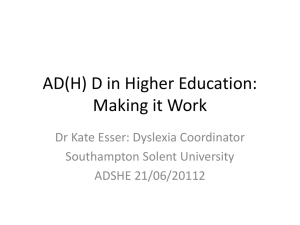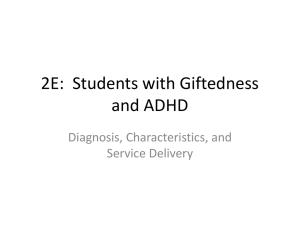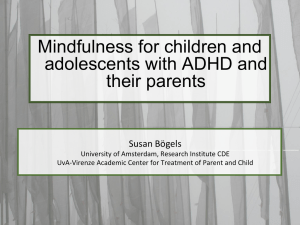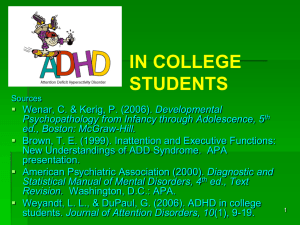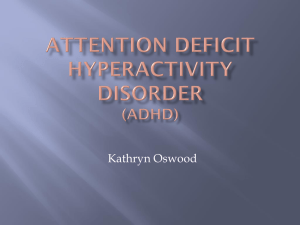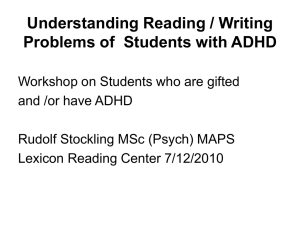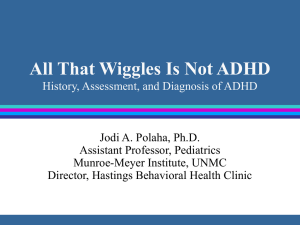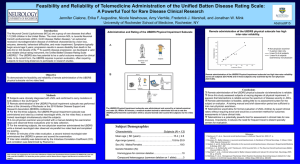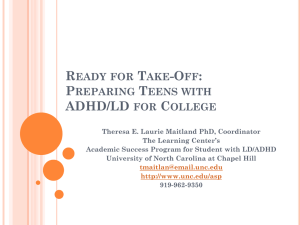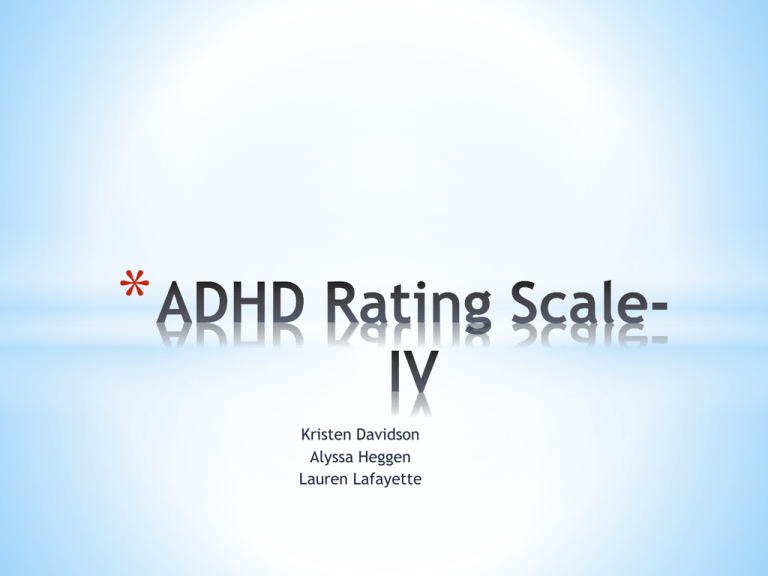
*
Kristen Davidson
Alyssa Heggen
Lauren Lafayette
*
* Norm-referenced checklist measuring
symptoms of ADHD
* Measures both inattentive and hyperactive-impulsive type
* Home and school version
* 18-item questionnaire using a Likert Scale
* Approximately 5 minutes to complete
* The purpose….
* Means of gathering data regarding frequency of behaviors
from teachers and parents
* Used by clinicians to screen, diagnose, or evaluate treatment
of ADHD
*
* Created in 1998 by George J. DuPaul, Thomas J.
Power, Arthur D. Anastopoulos, and Robert Reid
* Unlike other ADHD measurements, the ADHD Rater
Scale-IV provides clinicians with parent AND teacher
ratings using DSM-IV guidelines
* Developed using a 4-point Likert Scale method
* Each scale item represents a symptoms described
by the DSM-IV, without the use of “often”
*
* Ages 4-20
* Any ethnicity or sex
* Versions for parents and teachers
* Parent version is available in Spanish
* Administration of both types is preferable
*
School Version:
*
Participants ranged from ages 4-19 years in age
*
Most children attended general education vs. special education (1816 to 161)
*
Participants were identified as living in one of four regions of the US (Midwest, Northeast, West,
Northeast)
*
Racial distribution was Caucasian, African-American, Latino, Asian-American, and Native American
Home Version
*
Participants ranged from ages 4-19 years in age
*
Participants were identified as living in one of four regions of the US (Midwest, Northeast, West,
Northeast)
*
Racial distribution was Caucasian, African-American, Latino, Asian-American, and Native American
*
Parents respondents identified themselves as Caucasian, African-American, Latino, Asian-American,
and Native American
*
Families were primarily living in middle-class socioeconomic status
*
Parent respondents were 1,753 female and 244 male
*
* The reliability and validity of the Home and School versions of the
ADHD Rating Scale-IV were evaluated
* Results indicated adequate levels of internal consistency, test-retest
reliability, and cross-informant agreement for both parent and teacher
ratings.
* Discriminate validity-results found that both Home and School versions
of ADHD Rating Scale-IV were found to discriminate significantly
between children with and without ADHD.
* Further the ADHD Rating Scale-IV can be used to differentiate between
children with ADHD from other clinic-referred children as well as
differentiate among the combined and inattentive subtypes of ADHD
* Additional research is needed to verify the generalizability of the
properties and utility of this scale across geographic regions, ethnic
groups and socioeconomic groups.
*
* Results are described in terms of the Inattention and Hyperactivity-
Impulsivity subscales, the total score, and percentile ranks for each
score.
* The Inattention subscale is scored by summing the responses on all
the odd-numbered items (Items 1, 3, 5, 7, 9, 11, 13, 15, 17).
* The Hyperactivity-Impulsivity subscale is scored by summing the
responses on all the even-numbered items (Items 2, 4, 6, 8, 10, 12,
14, 16, 18).
* Using the child’s gender and age (and the appendix), raw scores are
converted to percentile scores.
* If an item on the rating scale is missed, the respondent should be
directed to provide an answer. If 3 or more items are skipped by
the respondent, extreme caution should be used in interpreting the
scale for any of the intended purposes.
*
* Diagnosing ADHD/I-
* Inattention subscale (teacher) ≥ 90th percentile
* Inattention subscale (parent) ≥ 93rd percentile
* Hyperactivity-Impulsivity subscale (teacher) ≤ 85th percentile
* Ruling out ADHD/I
* Inattention subscale (teacher) < 80th percentile
* Inattention subscale (parent) < 85th percentile
* Diagnosing ADHD/COM
* Inattention subscale (teacher) ≥ 90th percentile
* Inattention subscale (parent) ≥ 93rd percentile
* Hyperactivity-Impulsivity subscale (teacher) ≥ 98th percentile
* Ruling our ADHD/COM
* Inattention subscale (teacher) < 80th percentile
* Inattention subscale (parent) < 85th percentile
* Hyperactivity-Impulsivity subscale (teacher) < 85th percentile
*
* Strengths:
-based on the DSM-IV
-completed in 5 minutes
-sound psychometric features
-can be used with other assessments
-normative sample closely matches census data
* Weaknesses:
-data was not provided separately for ethnic groups
-over diagnosis in African-American boys
-more research needs to be done to determine the best use in all
multi-cultural groups as well as the difference in setting between
the scales
*
* Addwarehouse.com
$55.00
* Includes teacher and parent report with permission to copy as
many times as needed
*
Must fill out a “Qualification Form” from the website (in
accordance with the ethical and professional standards of the
American Psychological Association and the Standards for
Educational and Psychological Testing) before being eligible to
purchase the test
* Purchasers of this type of test must have completed graduate level
courses in tests/measurement or have received equivalent
documented training.
* The purpose of this scale is to provide clinicians with a means of
gathering information regarding the frequency of certain
behaviors from teachers and parents. This information may be
used by clinicians to assist in screening, diagnoses, or evaluation
for the treatment of ADHD.
* Quick and easy way to gather more information from important
stakeholders invested in the child’s education and well-being.
* Treatment and intervention can begin as soon as the results are
available after the first session
* Allows parents to take an active role in child’s education
*
A.D.D. WareHouse. (2009). A.D.D. WareHouse. Retrieved from http://www.addwarehouse.com/shopsite_sc/store/html/adhd-rating-scaleiv.html
Anastopoulos, A.D. & Shelton, T.L. (2001). Assessing attention deficit/hyperactivity disorder. New York: Kluwer Academic/Plenum
Publishers.
DuPaul, G.J., Power T.J., Anastopoulos, A.D. & Reid, R. (1998). ADHD rating scale-IV: checklists norms, and clinical interpretation. New
York: Guilford.
DuPaul, G.J., Power, T.J., McGoey, K.E., Ikeda, M.J., & Anastopoulos, A.D. (1998). Reliability and validity of parent and teacher ratings of
Attention-Deficit/Hyperactivity Disorder symptoms. Journal of Psychoeducational Assessment, 16, 55-68.
Pappas, D. (2006). Review of 'ADHD rating scale-IV: Checklists, norms, and clinical interpretation'. Journal of Psychoeducational
Assessment, 24, 172-178. doi:10.1177/0734282905285792

